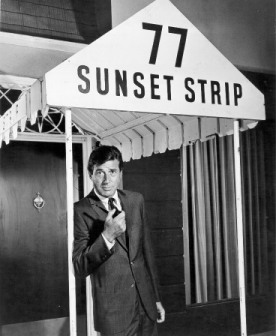
206 Episodes, ABC
Credits:
Executive Producer - Wm. T. Orr (seasons 1-5)
Jack Webb (season 6)
Producers - Howie Horwitz, Fenton Earnshaw, William Conrad
Regular cast:
Stuart Bailey - Efrem Zimbalist, Jr.
Jeff Spencer - Roger Smith (seasons 1-5)
Gerald Lloyd Kookson III ('Kookie') - Edd Byrnes (seasons 1-5)
Roscoe - Louis Quinn (seasons 1-5)
Suzanne Fabray - Jacqueline Beer (seasons 1-5)
Lt. Gilmore - Byron Keith (seasons 1-5)
Rex Randolph - Richard Long (season 3)
Hannah - Joan Staley (season 6)
J. R. Hale - Robert Logan (seasons 4, 5)
[Parts of this text ran in Television Chronicles magazine, No. 12, © 1998]
77 Sunset Strip is fondly remembered by many as the quintessential private eye TV series. Handsome men chased nasty bad guys while finding time to romance beautiful girls This wasn't hard-boiled Raymond Chandler-type stuff either. The action took place in the bright Southern California sunshine, in the playground of the rich and famous. Despite the fact that the show has run only once in Seattle since the 1960s [it is currently running on a few cable systems on the METV Channel], 77 has maintained a mystique even for those who never saw it, because it is reflected in so many TV detective series which came after it.
The first crime drama on television was Barney Blake, Police Reporter. This live NBC series ran 13 weeks in 1948 before it was cancelled by its sponsor. The following fall, there were six live crime series, including the ABC collaboration with Look magazine, Photocrime, starring Chuck Webster as Inspector Hannibal Cobb. Ken Lynch played the unseen lead in The Plainclothesman on the old DuMont network, and the show used the Lieutenant's point of view-literally-with the camera lens tilting up when he was knocked out or blinking when he got something in his eye. Then the more conventional Martin Kane, Private Eye made its way from radio to NBC-TV.
A precursor of things to come began that year with CBS's Man Against Crime. It was set in New York and done live until 1952, when it switched to film, using the Edison Studios in the Bronx for interiors and real New York locations for exteriors. Ralph Bellamy played Mike Barnett and Robert Preston played his brother Pat. Dragnet and Joe Friday moved from radio to the tube, giving us the archtypical hard-boiled TV cop. Eventually, many of the creators of later crime dramas and action adventure shows cut their teeth at Webb's production company.
Early television not only picked up radio's style, it reflected its east coast roots. Flatfoot gumshoes plodded dirty urban streets, but that would change rapidly. Weather hadn't mattered on radio, and the networks had always been based in the east. But TV heard the call to go west and it did. Right to Dodge City.
The first TV-style adventure shows were westerns. By 1959, there were 28 westerns in prime time every week. In 1955, ABC had signed a deal with Warner Bros. to produce programming for the network. ABC was behind both CBS and NBC in its number of affiliate stations because it was formed later than the other two. In many cities by 1958, ABC either didn't have a station or was on a UHF channel, and most TV sets at the time didn't have the UHF channels. So none of ABC's shows had anywhere near the audience that shows on the other two networks did, so were much lower in the ratings. The hit shows Warner Bros. made for ABC, from Maverick to Hawaiian Eye, probably saved the network from extinction. Many of them were bona fide hits and not only brought ABC viewers, they gave the network an image, albeit a Warner Bros. one.
According to Ed Robertson's book, Maverick: Legend of the West, studio head Jack L. Warner had to be dragged kicking and screaming into the television age. Director Richard L. Bare, quoted in Robertson's book, remembered, 'J. L. wouldn't allow me, or any of his other directors, to have a TV set any place visible on the [film] set.' But Warner finally accepted the inevitable. Warner Bros. Presents premiered in 1955 with a 'wheel' show. It alternated three different series: Cheyenne, Casablanca and Kings Row--all based on Warner films. Only Cheyenne was a hit, and in 1956, it alternated with an anthology show, Conflict, which begat many things, including bringing Efrem Zimbalist, Jr. and James Garner into the Warner Bros. television fold.
After a short, rocky start, with someone else, William T. Orr became head of Warner Bros. television and he began to put together producers, directors and writers who would mold shows for the studio and ABC. Jack L. Warner hated paying for material when he already had so much, and he wanted his TV division to use as much Warner-owned material as possible as the basis for its shows. Roy Huggins had been hired from Columbia after the first few episodes of Cheyenne had failed to please the sponsor. The next year, with Cheyenne a hit, Huggins moved on to Conflict and on it, he first worked with James Garner (who wound up as the star of Maverick), did the pilots for 77 Sunset Strip and Bourbon Street Beat and produced several other stories which would be cannibalized when the studio needed scripts for its shows during the 1961 writers strike.
Roy Huggins had the idea to make contemporary westerns which replaced the cowboys on horseback with private eyes in convertibles. The first of these, 77 Sunset Strip, was California personified. Daring detectives, a wisecracking parking attendant and clean ribbons of broad boulevards for their big cars were the elements that made it work. Roy Huggins said, 'I had managed to get ABC to see the wisdom of doing for the first time-on film-a one-hour private eye series. I had sold them Maverick, I had sold them a different kind of one-hour series and then I thought why in the world don't I come up with a one-hour private eye series, which is original. No one's ever done that. Cheyenne I'd already done, which was the first one-hour western series.'
The premise for 77 Sunset Strip is that Bailey & Spencer is a highly-regarded private eye firm based in the small office building next to Dino's Restaurant on the Strip. Stu Bailey and Jeff Spencer are equally effective at solving cases, though Bailey does it more with brains and experience, while Spencer is more adept at physical heroics and romancing the ladies. He also sings and plays the guitar. Jeff occasionally calls Stu 'the professor,' for his intelligence and fluency in several languages, though Spencer himself also has wide experience and smarts. Both agents frequently go undercover to solve their cases. They have excellent relations with the police, usually in the person of Lieutenant Roy 'Gil' Gilmore (Byron Keith).
In the lobby of their building, Suzanne Fabray-a beautiful Frenchwoman (played by Jacqueline Beer, 1954's 'Miss France')-runs the Sunset Answering Service, but she really serves as receptionist for Bailey & Spencer, and in later seasons, often goes undercover for them on cases. Jeff and Stu maintain their contacts in the underworld and on the street via Roscoe (Louis Quinn), who digs up information when not at the track betting on a series of no-good nags. Meanwhile, valet parker Kookie is always ready to jump in his hot rod and run down some information for the private eyes and constantly begs to be allowed in on their cases.
77 Sunset Strip was not only a hit, it also introduced a style and substance which would pervade TV action shows for a decade. First, the heroes were not legends of a distant past, as the western stars had been. These were very contemporary men in modern situations and the audience identified with them. They had interesting jobs, danger and above all, a potent way with women. And their style-from Kookie's casual wear to Stu and Jeff's lightweight suits-was pure California. They seldom wore hats and they drove flashy open cars. By making Kookie a parking attendant, the show captured the southern California lifestyle of driving everywhere. And the actors were all a teen-aged girl's dream.
Efrem Zimbalist, Jr. (Stu Bailey) is the son of a world-famous violinist and opera singer and was bitten by the acting bug in his late teens. After his military service, he pursued his career in Hollywood after working on a CBS soap. He appeared in Sugarfoot, two episodes of Conflict and five of Maverick, before being cast as Stu Bailey, a suave private eye who had government top secret service in his background. Both Huggins and Orr were fans of his acting style and he was a solid anchor for the series. He would go on to a long run (nine years) as the star of The F.B.I. In addition to many guest appearances on all networks, he also played a recurring character on his daughter Stephanie's hit ABC series Remington Steele, followed by Hotel and a one-season stint as the father of Duncan Regehr's Zorro. He also provided the voice of butler Alfred on the Batman cartoon series.
Roger Smith (Jeff Spencer) came to 77 already a Warners veteran, too, having just costarred as the grownup Patrick Dennis in the hit film, Auntie Mame starring Rosalind Russell. Though born in Los Angeles and being part of a children's acting troupe, Smith was raised in Nogales, Arizona and attended the university there. After service in the navy, James Cagney became his mentor and Smith appeared in Man of a Thousand Faces after he'd made several unmemorable films and a few TV guest-starring roles.
Smith had an alarming tendency to be accident-prone, as reported in TV Guide. Series producer Howie Horowitz was quoted as saying, 'Rog needs another accident like he needs a third hole in his head,' referring to a freak accident in Smith's home which resulted in him having two holes drilled in his skull to relieve a brain hemorrhage. This laid up the energetic actor for some time. First married to actress Victoria Shaw, he is now in a long-tem marriage to Ann-Margret, and has managed her career for decades. He wrote seven episodes of 77 Sunset Strip including the famous 'The Silent Caper,' which has not one line of dialogue.
But despite these two very handsome stars, it was Edward (aka Edd) Byrnes as first a sociopathic killer-for-hire in the pilot and then as the comb-toting parking attendant Kookie (short for Gerald Lloyd Kookson III), who got the attention and the screaming female fans. Byrnes received 15,000 fan letters a week, and in his autobiography, Kookie No More, he admits it all went to his head and he started abusing alcohol and drugs. Byrnes was also a Warner player, and had appeared in the studio's other shows before being given the role of Kookie. Despite his desire to shed the image, Byrnes's characterization was a main factor in the show's success. Byrnes eventually conquered his addictions and has continued to act and has done dozens of guest-starring roles in series from Mr. Roberts (which starred Roger Smith) to Murder, She Wrote.

|
|
|
| | 


